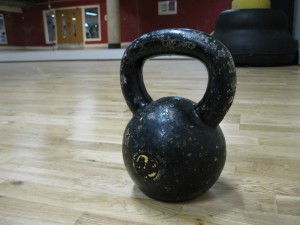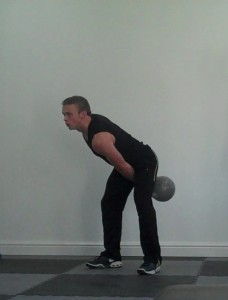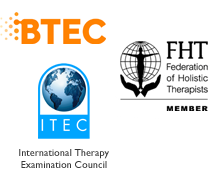In this article I take a look at Kettlebell training, specifically:
- Benefits of exercising with kettlebells
- Examples of kettlebell exercises
- Muscles used in kettlebell training
- How massage can help those doing kettlebell training.
Kettlebells are iron balls with handles, offering training using dynamic moves targeting strength, balance, agility and cardio endurance. It is possible to work virtually your entire body with just a small group of kettlebell exercises. Results can be extraordinary and the technique is popular. Kettlebells can be used by men and women, to help you achieve your fitness goals, transform your body and provide a challenging and fun workout! Because we typically sit so much these days, our core muscles become weak and our ‘posterior chain’ (back of the body) tight and stressed. Kettlebells address this imbalance. A dynamic workout is also a motivational way to work stress out of the body. Kettlebell training demands you maintain your centre of gravity whilst supporting a moving load. Swinging the heavy kettlebell creates a displaced centre of gravity, which the body has to respond to.
Note: This article does not relate to kettlebell technique. It is essential to work under the guidance of a qualified instructor.
Benefits of Exercising with Kettlebells
1. Fat Loss and Toning: Kettlebells are awesome for fat loss and muscle toning due to the intense workout, keeping your metabolic rate raised after you finish your session – meaning more calories also burned at rest.
2. Functional Fitness: Kettlebells work the body through functional training, using movements our bodies were designed to do in real life: bending, squatting, twisting, swinging, pressing, pulling, pushing.
3. Increased Strength and Power: Kettlebell movements are ‘ballistic’, a form of strength training applying force, using fast twitch muscle fibres, where we lift, accelerate, and then release weight, rather than slowly lowering it. Ballistic training requires muscles to contract quickly and forcefully to develop muscular strength and power.
4. Condition, Stamina, Endurance: Kettlebell training can increase your condition, stamina and endurance enabling you to work out longer and harder, with less fatigue.
5. Core Strength and Stability: Kettlebell training encourages core stability, improving posture by working postural muscles in a functional way, helping reduce lower back problems, as core muscles strengthen and stabilise the spine. Weak and unbalanced core muscles are linked to low back pain as they are unable to help maintain appropriate posture and reduce strain on the lower spine.
6. Strong Posterior Chain: Muscles down the back of the body: back muscles, glutes, hamstrings and posterior calves play a key role in many lifts, promoting a stronger posterior chain.
7. Fun! The gym can become monotonous and boring – kettlebells workouts are dynamic, varied and fun.
Examples of Kettlebell Exercises
1. Swing: Embodies speed, power, strength, and endurance, it leaves muscles fatigued and your body catching its breath. Swings can be one or two-handed, powerfully working core, back and shoulders, arms, glutes, hamstrings, quadriceps and driving through the hips as the ball is raised to chest level.
2. One-Arm Clean: Builds strength and endurance, involving both a swing and lift component. The upper body gets a workout as the kettlebell is lifted up against your upper arm.
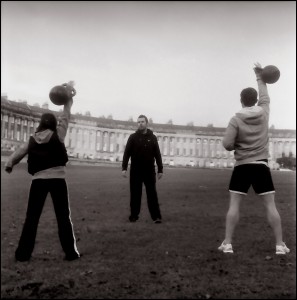 3. One-Arm Snatch: Builds explosive strength, power and endurance. Similar in form to Swing, Kettlebell Snatch differs in the end point, where the kettlebell is punched overhead, making core muscles work hard to keep your body stable through the punch.
3. One-Arm Snatch: Builds explosive strength, power and endurance. Similar in form to Swing, Kettlebell Snatch differs in the end point, where the kettlebell is punched overhead, making core muscles work hard to keep your body stable through the punch.
4. Deadlift / Stiff Leg Deadlift: Help tone and strengthen hamstrings, core, lower back and glutes.
5. Windmill: Involves twisting to touch your opposite foot, placing emphasis on abdominals (particularly obliques) and building a strong back, arms and shoulders – with the bonus of working on balance and stability.
6. Lunge: By extending a leg and lowering the body’s centre of gravity, resistance is displaced onto the leg muscle areas to firm the lower body.
7. Squats: Works quadriceps, gluteals and hamstrings.
Muscles Used in Kettlebell Training
Hamstrings: The hamstrings get called into play when your knees go from a straight to bent position. Any squatting exercise will recruit the hamstrings. They are also contracted for stabilisation with exercises like one/two arm swings, single or double snatch, and clean and press.
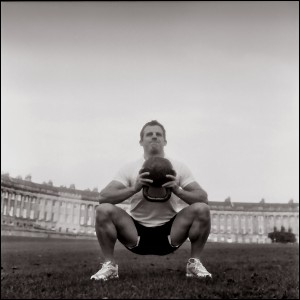 Quadriceps: The quads primarily extend the knee. One of the quads (rectus femoris) also crosses the hip joint and is a hip flexor. Any type of squat with kettlebells activates your quads.
Quadriceps: The quads primarily extend the knee. One of the quads (rectus femoris) also crosses the hip joint and is a hip flexor. Any type of squat with kettlebells activates your quads.
Back Muscles: Classic kettlebell movements like snatch, clean and swing involve heaving the kettlebell from the ground up into the air, so your back muscles are involved. Latissimus dorsi, rhomboids and erector spinae get recruited with any exercise that involves a pulling (“rowing”) motion toward your body.
Shoulders: Overhand grip for swinging kettlebell exercises works shoulders and arms. Gripping the kettlebell tones forearms. Overhead clean and press, or even basic snatch, works shoulders: levator scapula, trapezius, deltoids and rotator cuff. Shoulder muscles are stabilisers with all kettlebell exercises and any exercise involving an overhead movement.
Gluteals: The gluteals are located in the buttock region. Different fibres of these muscles flex, extend, abduct or externally rotate the hip, so your glutes get recruited when your thighs go from a close body position to a straight leg position, or vice versa. These muscles are also recruited for stability when doing swings and deadlifts.
Core : The “core” muscles stabilise the spine and pelvis, and some run the entire length of the torso. When you lift, swing or even hold the bell, you contract your abs to maintain postural alignment and stability, and create a solid base of support, allowing you to generate powerful movements of the extremities whilst protecting the back. Rectus abdominis (“six pack”), obliques, transverse abs and erector spinae are all core muscles.
How Massage Helps Those Doing Kettlebell Training
 Kettlebells is a demanding form of training using the whole body. Many of us sit all day for a desk-based job, then train rigorously and physically, placing two very different sets of demands on the body. If muscles are already stiff and tight, we risk injuring ourselves and our recovery from exercise will be slow – and sore! Any new form of training places the body under mechanical stress, and although movements in kettlebell training are what our bodies were designed for, they are not what our bodies are necessarily used to doing, as modern lifestyles mean we sit a great deal, getting stiff and inflexible. We need to ensure our bodies are in the best shape for training. Regular massage will mean you enjoy sessions more, as muscles will be supple, flexible and better able to cope with the demands of your sport. Massage reduces micro-scarring and adhesions in muscles from day to day posture, lifestyle or existing injury, and gets blood flowing through tissues, allowing oxygen and nutrients to feed muscles and aid repair, ensuring tissue health. Christina will examine demands of your training / sport, but also your lifestyle OUTSIDE sport, which may contribute to muscular tightness and imbalance.
Kettlebells is a demanding form of training using the whole body. Many of us sit all day for a desk-based job, then train rigorously and physically, placing two very different sets of demands on the body. If muscles are already stiff and tight, we risk injuring ourselves and our recovery from exercise will be slow – and sore! Any new form of training places the body under mechanical stress, and although movements in kettlebell training are what our bodies were designed for, they are not what our bodies are necessarily used to doing, as modern lifestyles mean we sit a great deal, getting stiff and inflexible. We need to ensure our bodies are in the best shape for training. Regular massage will mean you enjoy sessions more, as muscles will be supple, flexible and better able to cope with the demands of your sport. Massage reduces micro-scarring and adhesions in muscles from day to day posture, lifestyle or existing injury, and gets blood flowing through tissues, allowing oxygen and nutrients to feed muscles and aid repair, ensuring tissue health. Christina will examine demands of your training / sport, but also your lifestyle OUTSIDE sport, which may contribute to muscular tightness and imbalance.
Massages should form part of your training plan: a preventive role: don’t wait until you have an injury – this is maintenance, keeping muscles flexible and supple in the first place, minimising stiffness and reducing ‘pull’ on tendons so you can work your muscles harder. Regular massages maintain tissue health and assist with recovery, flexibility, prevent injury and ensure muscles are relaxed for future training. It identifies small problems before they develop into an injury. Sports massage is also key for injuries sustained, but don’t let it get to that stage!
Tight, tired muscles do not work as well and are more prone to injury.
Benefits to regular massage – Recovery | Injury Prevention | Rehabilitation | Body Awareness | Psychological
- Stimulates blood circulation, increasing flow of oxygen and nutrients to cells and tissues
- Restores flexibility to tight, sore muscles; enhances flexibility
- Relieves chronic muscular stress; breaks down scar tissue and micro-scarring through ‘stuck’ muscle fibres. Loosens bound fascia and alleviates trigger points within muscles.
- Encourages flow of lymph, helping metabolic waste be drained away
- Reduces pain by stimulating release of endorphins (the body’s natural painkiller)
- Tailored techniques: Deep tissue massage, Muscle energy techniques, Soft tissue release, Neuromuscular techniques, Postural assessment.
- Psychological: you’ll feel good and in peak condition; a confidence booster.
- Every treatment can be tailored to be relaxing yet deeply effective, or more technical.
No! Christina creates bespoke treatments using techniques and pressure that’s right for you, without a “no pain, no gain” approach; even soothing Swedish massage incorporating deep tissue work can be effective. A little aching or soreness can be experienced where we’ve worked through tight tissues, but this gets less as sessions go on and tissue health improves. Remedial work hurts more, but preventive work helps avoid getting to that stage in the first place.
I’m not a serious athlete; surely I don’t need massage?
Whether you’re an Iron Man or Sunday morning footballer, massage helps. Muscle imbalances originate from structural, environmental or emotional factors; massage helps address them all.
When during my training should I have a sports massage?
Have your massage on a “rest day”; your muscles will be in a state of repair after massage and you do not want to put them through more stress by exercising immediately afterwards. Massage temporarily reduces “explosive” quality of muscle fibres by separating them, which would make your training session less effective and more tiring. So put your feet up and allow your muscles to rest and repair.
Where can I find more information and how do I book a massage with Christina?
Contact Christina at Pure Urban Massage on 07739 572985 or see www.pureurbanmassage.com.
© Christina Warren, Pure Urban Massage

